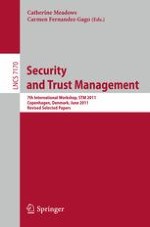This book constitutes the thoroughly refereed post-conference proceedings of the 7th International Workshop on Security and Trust Management, STM 2011, held in Copenhagen, Denmark, in June 2011 - co-located with IFIPTM 2011, the 5th IFIP International Conference on Trust Management. The 12 revised full papers presented together with 4 invited papers were carefully reviewed and selected from 33 submissions. Focusing on high-quality original unpublished research, case studies, and implementation experiences, STM 2011 features submissions from academia, industry, and government presenting novel research on all theoretical and practical aspects of security and trust in information and communication technologies.
